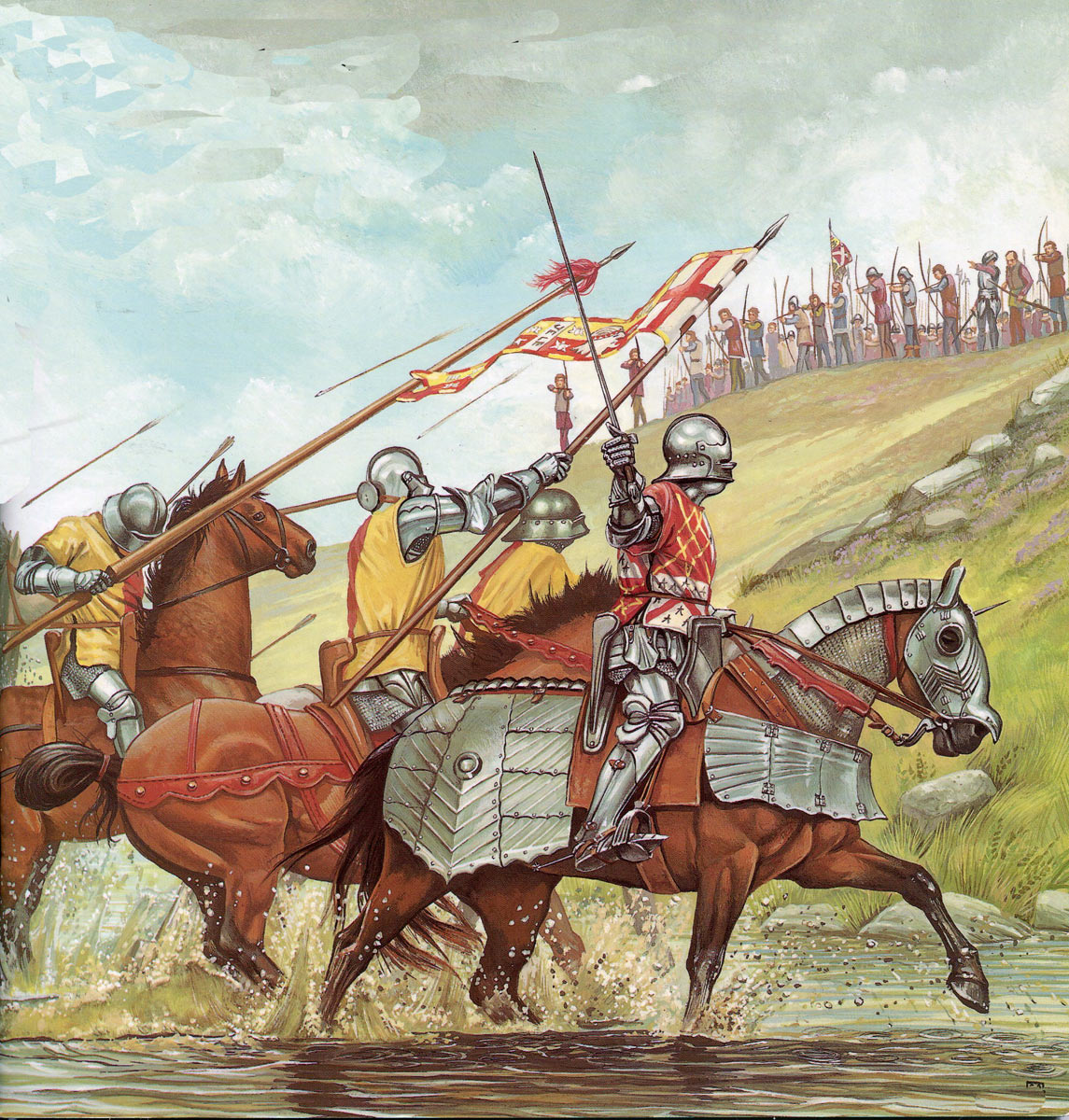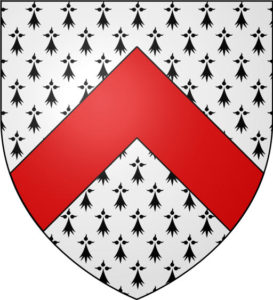The battle fought on 23rd September 1459, at which the Earl of Salisbury’s Yorkist army defeated a larger Lancastrian army, enabling it to join the Duke of York at Ludlow
The previous battle in the British Battles series is the First Battle of St Albans
The next battle in the Wars of the Roses is the Battle of Northampton
Battle: Blore Heath
War: Wars of the Roses
Date of the Battle of Blore Heath: 23rd September 1459
Place of the Battle of Blore Heath: In Staffordshire, near the Shropshire town of Market Drayton.
Combatants at the Battle of Blore Heath: Lancastrians against the Yorkists, in the civil war that wracked England in the 15th Century.
Commanders at the Battle of Blore Heath: James Touchet, Lord Audley, a powerful nobleman with extensive lands in Staffordshire, Shropshire and Cheshire, commanded the Lancastrian army.
Audley served under King Henry V, in the Wars in France and pursued a long-standing grievance against the Yorkist leadership, arising from a dynastic quarrel.
Richard Neville, Earl of Salisbury, commanded the Yorkist army. Salisbury, aged 60, a nobleman with substantial estates, principally in Yorkshire, saw military service in France and at the First Battle of St Albans.
Size of the armies at the Battle of Blore Heath: The Lancastrian army probably comprised some 10,000 men. The army was strong in cavalry.
The Yorkist army probably comprised some 5,000 men.
Both armies comprised substantial forces of archers, along with knights and men-at-arms (mounted men, but not knights).
Salisbury’s Yorkist army was denounced in the Act of Attainder issued by Parliament at Leicester in 1459. The Act named five knights; Sir John and Sir Thomas Neville (sons of Salisbury), Sir Thomas Harrington, Sir John Conyers and Sir Thomas Parr and gave the number of men in Salisbury’s army as 5,000.
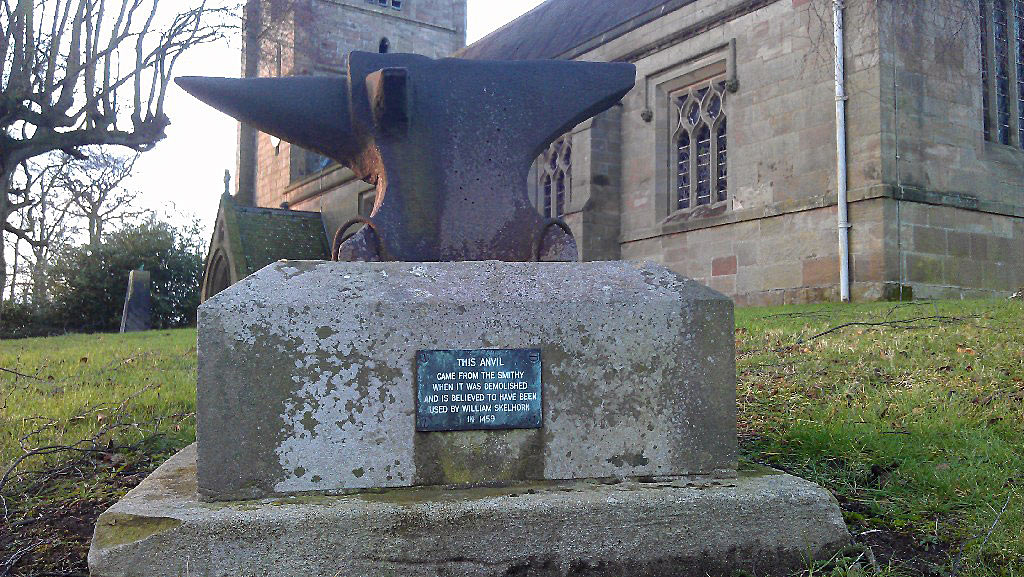
The Anvil said to have been used by William Skelhorn to re-shoe Queen Margaret of Anjou’s horse with the shoes reversed, to assist her escape after the Battle of Blore Heath, fought on 23rd September 1459 in the Wars of the Roses
Winner of the Battle of Blore Heath: The Yorkists, decisively.
Uniforms, arms and equipment at the Battle of Blore Heath: The senior commanders and their noble supporters and knights rode to battle on horseback, in armour, with sword, lance and shield.
Their immediate entourage comprised mounted men-at-arms, in armour and armed with sword, lance and shield, although often fighting on foot.
In addition to knights and men-at-arms, both armies comprised strong forces of longbowmen.
Handheld Firearms were beginning to appear in numbers on the battlefield, but were still unreliable and dangerous to discharge.
Artillery, although widely used in warfare, was heavy, cumbersome and difficult to move and fire.
There is no indication that firearms were used at the Battle of Blore Heath.
The end of the Hundred Years War caused numbers of English and Welsh men-at-arms and archers to return to their home countries from France. The wealthier English and Welsh nobles were able to recruit companies of disciplined armed retainers from these veterans, forming the backbone of their field armies.
Background to the Battle of Blore Heath: Following the Yorkist victory in the First Battle of St Albans, the Duke of York and his supporters controlled King Henry VI and were the effective governors of England.
This situation ended in October 1456, when Queen Margaret and her Lancastrian adherents again took control of government.
The Duke of York was made Lieutenant of Ireland, to remove him from the political scene in England, but failed to leave the country.
In 1459, Queen Margaret assembled an army at Leicester, against the Duke of York, who was at Ludlow. By the end of the summer the Lancastrian army was ready to move.
In September 1459, York sent urgent messages to the Earl of Salisbury, to join him with such troops as he could raise on his estates in Yorkshire and to the Earl of Warwick, serving as Captain of Calais, to bring over such troops as could be spared from the town’s garrison.
Queen Margaret, marching to attack York at Ludlow, ordered Lord Audley to prevent Salisbury from joining the Duke of York.
Audley’s estates lay around Market Drayton, so that he was ideally placed to intercept Salisbury’s Yorkist army, as it marched to Ludlow.
Queen Margaret’s orders to Audley were to bring Salisbury to her ‘dead or alive’.
Audley’s Lancastrian army and Salisbury’s Yorkist army met at Blore Heath, on the road between Newcastle-under-Lyme in Staffordshire and Market Drayton in Shropshire.
———————————-
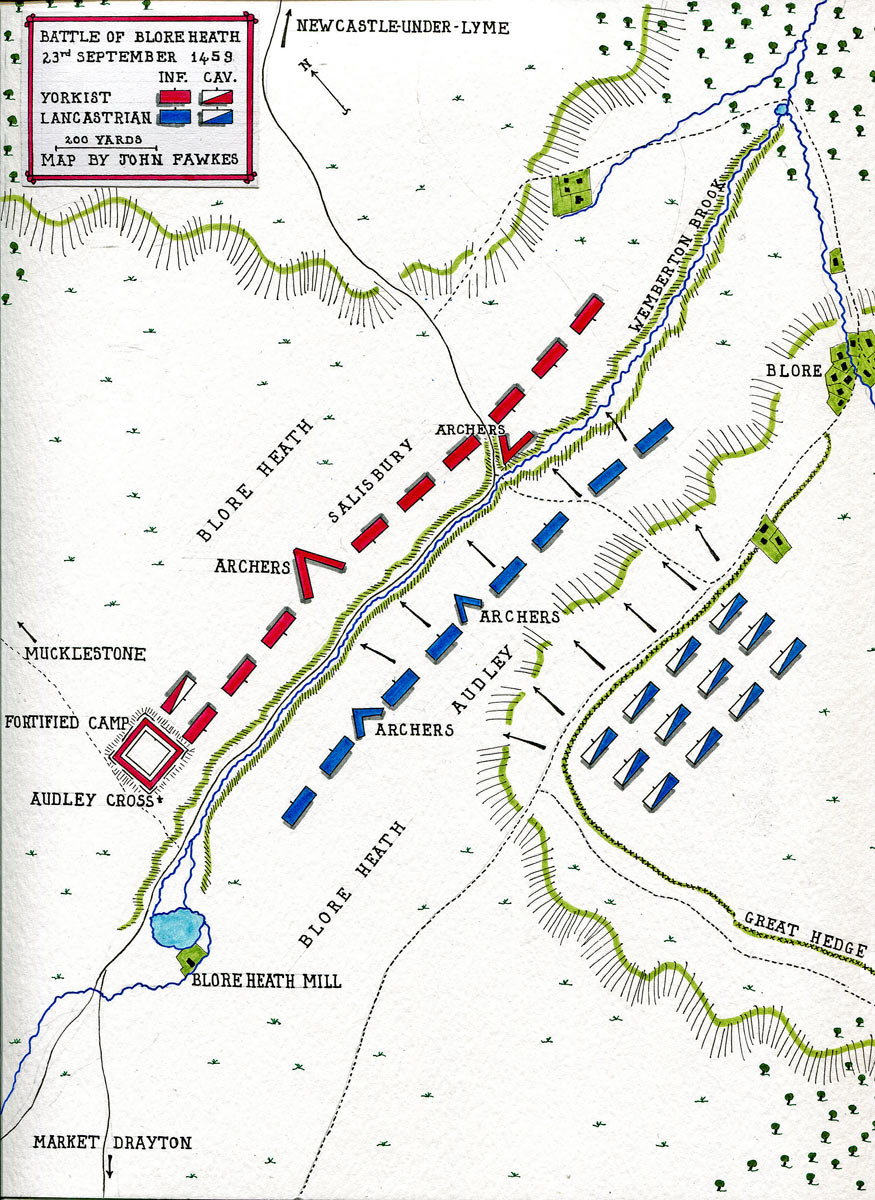
Map of the Battle of Blore Heath, fought on 23rd September 1459 in the Wars of the Roses: map by John Fawkes
Account of the Battle of Blore Heath: Lord Audley marched to the north-east of Market Drayton and formed his army on the rising ground to the south of the Market Drayton to Newcastle-under-Lyme road, where the road turned to the north, on the northern edge of Blore Heath.
The Lancastrians drew up their army for battle behind a ‘Great Hedge’, positioned on the southern side of the road and a stream, the Wemberton Brook.
In front of the Lancastrian left wing, the main Market Drayton to Newcastle road and the Wemberton Brook lay in a steep sided defile. At the point where the road turned to the north, away from the Lancastrian position, the defile continued in front of Lancastrian right, carrying the Wemberton Brook alone.
Lord Audley kept his mounted men on their horses, rather than lining the defensive position on foot. He clearly intended to conduct the impending battle as a mounted engagement, taking advantage of his considerable preponderance in mounted men over the Yorkists.
The Yorkists came in sight of the Lancastrian position at daybreak, the defile, in which the road and stream lay, between them and the Lancastrians.
The Yorkists halted on the edge of the defile and began to prepare a defensive position.
The Yorkist wagons were formed into a fortified camp on the right, opposite the end of the Lancastrian line.
The Yorkist knights and men-at-arms formed up in three divisions, two to the west of the north running limb of the road, forming the Yorkist right and the third to the east of the road, the Yorkist left.
A wedge of Yorkist archers stood between the central and right divisions.

Audley Cross: erected near the place of Lord Audley’s death: Battle of Blore Heath, fought on 23rd September 1459 in the Wars of the Roses
The right end of the Yorkist line lay where the Audley Cross was erected after the battle.
The Yorkists spent what little time there was in fortifying their positions.
The battle began at around 1pm, with a heavy discharge of arrows by each side. The Yorkists are said to have suffered 20 casualties from this discharge and a loss of horses in the wagon camp, while the Lancastrians, with less adequate protection, lost some 200 men.
It is said that the Yorkists then caused the Lancastrians to launch a mounted attack by means of a feint retreat, followed by a return to their positions.
Claims of sophisticated tactics of this sort, with a recently assembled and disparate medieval army need to be treated with care. Probably such an army was only capable of the simplest of manoeuvres and any direction to withdraw might well lead to a precipitate retreat off the field.
It would seem that Lord Audley intended, in any case, to conduct the battle by way of a mounted assault. He needed to defeat the Yorkists and take Salisbury ‘dead or alive’, to carry out Queen Margaret’s instructions to him.
However, it came about, under cover of the discharge of arrows, Lord Audley led his mounted men in an attack, down into the defile.
The Yorkists discharged arrows into the Lancastrian cavalry, as they rode into the defile and attempted to mount the far side to reach the Yorkist line.
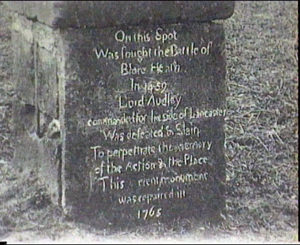
Inscription on the Audley Cross: erected near the place of Lord Audley’s death: Battle of Blore Heath, fought on 23rd September 1459 in the Wars of the Roses
The Lancastrian attack was repelled with significant casualties of around 500 to 600 men.
Lord Audley rallied his cavalry and launched a second charge. This time the Lancastrian attack was decisively repelled, with the loss of around 100 men, including Lord Audley who was killed.
Following Audley’s death, command of the Lancastrian army fell on Lord Dudley. Dudley ordered a further attack, this time on foot.
A significant body of Lancastrian knights and men-at-arms refused to dismount and watched as their brothers-in-arms struggled to cross the defile.
At this point, a body of some 500 of the Lancastrian knights and men-at-arms who had remained mounted, changed sides and attacked the rear of the advancing Lancastrians.
The Lancastrian army dissolved in flight and the Yorkists advanced to occupy their abandoned positions.
The dismounted Lancastrian knights and men-at-arms suffered considerable difficulty in trying to escape from the field, many being captured, including Lord Dudley, Sir Thomas Fitton and a dozen other knights. The battle ended at around 5pm.
Casualties at the Battle of Blore Heath: The casualties were probably some 2,000 Lancastrian dead, including the Lancastrian commander, Lord Audley, with around 200 Yorkist dead.
Follow-up to the Battle of Blore Heath: The Yorkists, in spite of their victory, were in an awkward position after the battle. They were scattered and exhausted. Queen Margaret was 15 miles away, at Eccleshall, with another Lancastrian army.
Thomas, Lord Stanley, was also nearby, at Newcastle-under-Lyme, with a force of some 2,000 men. His brother was with Salisbury at the Battle of Blore Heath.
Although the Earl of Salisbury was Stanley’s father-in-law and the Earl of Warwick was his brother-in-law, Stanley probably deliberately failed to appear on the battlefield of Blore Heath, as this would have required him to commit irrevocably to the Yorkist side. Throughout the Wars of the Roses, Stanley sat on the fence, until he decisively committed himself to Henry Tudor at the Battle of Bosworth Field.
However, after the battle, Lord Stanley sent a letter of congratulation to the Earl of Salisbury.
Stanley’s machinations did not prevent him from being denounced by the Leicester Parliament.
The Yorkist army encamped at Market Drayton, the night after the battle and, the next day, resumed its march to Ludlow to join the Duke of York.

St Thecla surrounded by lions: Battle of Blore Heath, fought on 23rd September 1459 in the Wars of the Roses: engraving by Hieronymus Wierix
Anecdotes and traditions from the Battle of Blore Heath:
- The Battle of Blore Heath was fought on St Thecla’s day. St Thecla, particularly venerated by the Eastern Church, was a follower of St Paul, who spent her life promoting the virtues of chastity. An attempt to burn her at the stake was thwarted by a storm and another attempt to have her eaten by wild lions was foiled, when the female lions turned on the males.
- After the Battle of Blore Heath, a stone cross, with an inscription, was erected near the spot where Lord Audley was killed. The stone is still there.
- The Yorkist knight reputed to have killed Lord Audley was Sir Roger Kynaston of Stocks in Shropshire. Sir Roger added the Audley arms to his own, in commemoration of the feat.
- It is said that Salisbury’s army was enabled to escape the approaching armies of Queen Margaret, after the Battle of Blore Heath, in part due to the repeated firing of a cannon, through the night, by a crazed friar, covering the Yorkist movements and distracting the Lancastrians.
- The Lancastrian position at the beginning of the Battle of Blore Heath was behind a ‘Great Hedge’. ‘Great Hedges’ existed across England, marking boundaries between parishes. A ‘Great Hedge’, typically, comprised two parallel hedges of substantial height, with a path or roadway running between them. A ‘Great Hedge’ played a prominent part in the English Civil War Battle of Chalgrove on 18th June 1643.
- By a local tradition, Queen Margaret of Anjou, the national Lancastrian leader, watched the Battle of Blore from the tower of Mucklestone Church, a mile and a half from the battlefield. Seeing her side lose the battle, Margaret rode off. Before doing so, Margaret is reputed to have had the shoes on her horse reversed by a local blacksmith, William Skelhorn, to confuse her pursuers.
- Another tradition has it that Queen Margaret was captured by one of Lord Stanley’s retainers, John Cleger, who robbed her and let her go.
References for the Battle of Blore Heath:
The Battle of Blore Heath by Paddy Griffith which incorporates the account of the battle by Colonel Twemlow
The Wars of the Roses by Michael Hicks
The Chronicles of the Wars of the Roses
British Battles by Grant
The previous battle in the British Battles series is the First Battle of St Albans
The next battle in the Wars of the Roses is the Battle of Northampton
